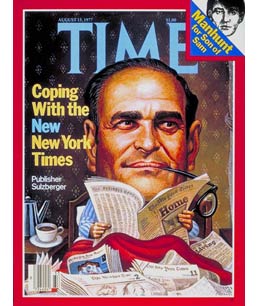
Arthur Ochs “Punch” Sulzberger, whose three-decade reign as New York Times publisher brought the paper 31 Pulitzer Prizes, died Saturday at the age of 86 after a long illness. Sulzberger, the only grandson of Times trailblazer Adolph S. Ochs and son of longtime publisher Arthur Hays Sulzberger, took over as publisher in 1963, after his brother-in-law Orvil E. Dryfoos died. At the time, Sulzberger was just 37 years old and serving as assistant treasurer.
Throughout his 34 years at the top, TIME documented Sulzberger’s tremendous — and at times contentious — success, analyzing his vast influence on the New York Times in particular and the world of journalism and broader society in general. Here’s a look back, through the archives, at TIME’s coverage of Sulzberger, his family and the Times over the decades.
Sulzberger appeared on TIME’s cover in 1977, the subject of a story that profiled not just the man, but also the ever evolving New York Times. The story tracked Sulzberger’s ascent from aloof assistant to formidable leader:
Punch Sulzberger was an amiable presence around the building, though when he attended an occasional story conference he sometimes seemed more interested in examining the air-conditioning ducts on the ceiling … He learned fast … While admirers and subordinates try to second-guess him, Sulzberger goes on tinkering with the wondrous machine he has inherited. (Aug. 15, 1977)
Eight years into his stint as publisher, Sulzberger oversaw what today remains one of the newspaper’s most controversial decisions: publishing the Pentagon Papers, a series of classified documents exposing details of the Vietnam War. While some major papers followed suit, others held back — and TIME sought to determine why:
As leaks continued, TIME polled two dozen editors across the U.S., asking how they would have played the story had they, and not the Times, received the Pentagon papers first. Although most newspapers do not command as much newsprint space as the Times, the great majority of editors, in the words of Denver Post Executive Editor William Hornby, “would have done just what the Times did.” (July 5, 1971)
In 1992, Sulzberger handed off his duties as publisher to his then 40-year-old son, Arthur Ochs Sulzberger Jr. TIME wrote a feature on this transition — the passing of a very weighty torch — and paid particular attention to the relationship between the new publisher and his father:
Reporters noticed a deeper affection growing between him and his father, “Punch” Sulzberger. One editor observed, “Arthur took on some of Punch’s winning characteristics — his self-deprecating humor, his listening rather than talking.” (He did not find it humorous, however, when people tried to stick him with the obvious diminutive “Pinch.”) (Aug. 17, 1992)
Although he relinquished his title as publisher, Sulzberger remained chief executive of the New York Times Co. until 1997. That year, TIME covered what it called the “most radical face-lift” the Times had attempted in 20 years — which, perhaps most notably, included running the paper’s first color photograph. TIME evaluated the paper’s obvious strengths but more subtle weaknesses:
On the one hand, it’s a rock of restrained, sober-minded news judgment in a media world that flies into paroxysms of excess every time an O.J. Simpson or JonBenet Ramsey comes along. Yet that same sobriety can make the paper seem stuffy and arthritic … The Times is easily the best, most important newspaper in the country, authoritative and unfailingly serious. Yet in some fundamental way, it is also out of the mainstream — snooty, austere and loathe to go near gossip, even when it concerns the performance of such major figures as President Clinton and New York City’s Mayor Rudolph Giuliani. (Sep. 29, 1997)
In 2003, TIME covered an “unprecedented downfall” in New York Times history: the plagiarism scandal surrounding young reporter Jayson Blair. The article addressed the subsequent resignation of top Times staffers — managing editor Gerald Boyd and executive editor Howell Raines — and discussed Sulzberger Jr.’s reactions:
Speaking to TIME last week, Sulzberger said he was saddened by the resignations but not because he was responsible for choosing Raines. “You make choices,” said Sulzberger. “Some work. Some don’t work. My heart was broken because these men were taking an act for the good of an institution that they and I love.” (June 16, 2003)
As the newspaper continued to undergo face-lifts and attempt to navigate a rapidly digitizing media landscape, TIME continued to document its evolution and assess its evolving business model:
A big printed shoe fell on Wednesday, when the New York Times partially lifted the veil on its plan to charge for access to its website … The Times has tried the charging-for-content trick twice before. In the early days of the Internet, it charged for access from overseas readers, and from 2005 to 2007, it tried TimesSelect, in which readers had to pay for access to its signature columns and opinion pieces. That experiment was abandoned. (Jan. 20, 2010)
Through it all, the influence of Arthur Ochs Sulzberger — who grew the paper’s size and influence — is undeniable.
MORE: Arthur Ochs Sulzberger, Former New York Times Publisher, Dies at Age 86






